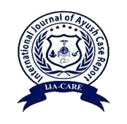The Role of Agnikarma in management of Avabahuka: A Case Report
Abstract
Agnikarma, an important Ayurvedic parasurgical procedure, is basically heat burn therapy used to treat diseases caused by Vata and Kapha dosha. The Avabahuka is Vata-vikar which is nearer to the frozen shoulder (FS) of modern science. The classical features of Avabahuka as well as Frozen shoulder are Shool (pain), Stambha (stiffness), and bahu-praspandithara (decreased range of motion) of the shoulder joint (Ansha sandhi). Various treatment modalities available for the treatment of that still some other possible modalities are expected. So a separate remedy by Agnikarma with Ayurvedic drugs was adopted to treat this case. A 52-year-old male patient has complaint of pain, and difficulty in motion of the right shoulder joint. The patient has been diagnosed as Avabahuka of the right shoulder joint based on history, clinical features, and examination. The Agnikarma as an intervention was decided and performed on the right shoulder joint of the patient. The Agnikarma subdues the Vata and Kapha dosha that is responsible for Avabahuka. After five sittings of Agnikarma, the pain and stiffness in the shoulder region reduced and also increased in the range of motion (ROM). The Agnikarma in Avabahuka has a promising effect.

This work is licensed under a Creative Commons Attribution-NonCommercial-NoDerivatives 4.0 International License.

